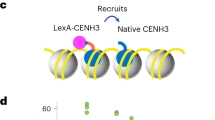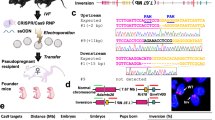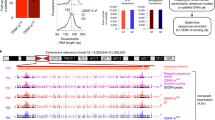Abstract
Human neocentromeres are fully functional centromeres that arise naturally in non-centromeric regions devoid of α-satellite DNA. We have successfully produced a series of minichromosomes by telomere-associated truncation of a marker chromosome mardel(10) containing a neocentromere. The resulting minichromosomes are either linear or circular in nature, and range in size from approximately 650 kb to 2 Mb. These minichromosomes exhibit full centromeric activity, bind to essential centromere proteins, and are mitotically stable over many generations. They provide a useful system for dissecting the functional domains of complex eukaryotic centromeres and as vectors for therapeutic gene delivery.
This is a preview of subscription content, access via your institution
Access options
Subscribe to this journal
Receive 12 print issues and online access
$259.00 per year
only $21.58 per issue
Buy this article
- Purchase on Springer Link
- Instant access to full article PDF
Prices may be subject to local taxes which are calculated during checkout


Similar content being viewed by others
References
Voullaire LE, Slater HR, Petrovic V, Choo KHA . A functional marker centromere with no detectable alpha-satellite, satellite III, or CENP-B protein: activation of a latent centromere? Am J Hum Genet 1993 52: 1153–1163
du Sart D et al. A functional neo-centromere formed through activation of a latent human centromere and consisting of non-alpha-satellite DNA Nat Genet 1997 16: 144–153
Barry AE et al. Sequence analysis of an 80 kb human neocentromere Hum Mol Genet 1999 8: 217–227
Barry AE et al. The 10q25 neocentromere and its inactive progenitor have identical primary nucleotide sequence: further evidence for epigenetic modification Genome Res 2000 10: 832–838
Saffery R et al. Components of the human spindle checkpoint control mechanism localize specifically to the active centromere on dicentric chromosomes Hum Genet 2000 107: 376–384
Saffery R et al. Human centromeres and neocentromeres show identical distribution patterns of >20 functionally important kinetochore-associated proteins Hum Mol Genet 2000 9: 175–185
Lo AW et al. A 330 kb CENP-A binding domain and altered replication timing at a human neocentromere Embo J 2001 20: 2087–2096
Lo AW et al. A novel chromatin immunoprecipitation and array (CIA) analysis identifies a 460-kb CENP-A-binding neocentromere DNA Genome Res 2001 11: 448–457
Choo KHA . Domain organisation at the centromere and neocentromere Dev Cell 2001 1: 165–177
Warburton PE et al. Molecular cytogenetic analysis of eight inversion duplications of human chromosome 13q that each contain a neocentromere Am J Hum Genet 2000 66: 1794–1806
Farr CJ et al. Generation of a human X-derived minichromosome using telomere-associated chromosome fragmentation Embo J 1995 14: 5444–5454
Heller R, Brown KE, Burgtorf C . Brown WR.. Mini-chromosomes derived from the human Y chromosome by telomere directed chromosome breakage Proc Natl Acad Sci USA 1996 93: 7125–7130
Saffery R et al. Construction of neocentromere-based human minichromosomes by telomere-associated chromosomal truncation Proc Natl Acad Sci USA 2001 98: 5705–5710
Brown WRA, Mee PJ, Shen MH . Artificial chromosomes: ideal vectors? Trends Biotech 2000 18: 218–223
Willard HF . Neocentromeres and human artificial chromosomes: an unnatural act Proc Natl Acad Sci USA 2001 98: 5705–5710
Choo KHA . Engineering human chromosomes for gene therapy studies Trends Mol Med 2001 7: 235–237
Saffery R, Choo KHA . Strategies for engineering human chromosomes with therapeutic potential J Gene Med 2002 4: 5–13
Author information
Authors and Affiliations
Rights and permissions
About this article
Cite this article
Wong, L., Saffery, R. & Choo, K. Construction of neocentromere-based human minichromosomes for gene delivery and centromere studies. Gene Ther 9, 724–726 (2002). https://doi.org/10.1038/sj.gt.3301756
Published:
Issue Date:
DOI: https://doi.org/10.1038/sj.gt.3301756
Keywords
This article is cited by
-
De novo formed satellite DNA-based mammalian artificial chromosomes and their possible applications
Chromosome Research (2015)
-
Towards safe, non-viral therapeutic gene expression in humans
Nature Reviews Genetics (2005)



